ATHABASCA, BOYLE – While dozens of important events took place across the Athabasca region there are 10 which stood out.
Losing workers at Athabasca University will have economic impacts on the town and area for years to come, COVID-19 is still an issue, it was a rare occurrence but now nine novice Athabasca County councillors are at the helm, emergency rooms closed for hours or a night or even multiple days both in Boyle and across the province as well as ambulances travelling further and further.
Good things happened too, like the return of the Magnificent River Rats Festival in a one-day event held on one of the hottest days on record as well as the unique sight of a man-made island anchored in the middle of the Athabasca River while the new intake pipe was being installed.
These are the Top 10 events which took place in 2021:
Keep Athabasca in Athabasca University
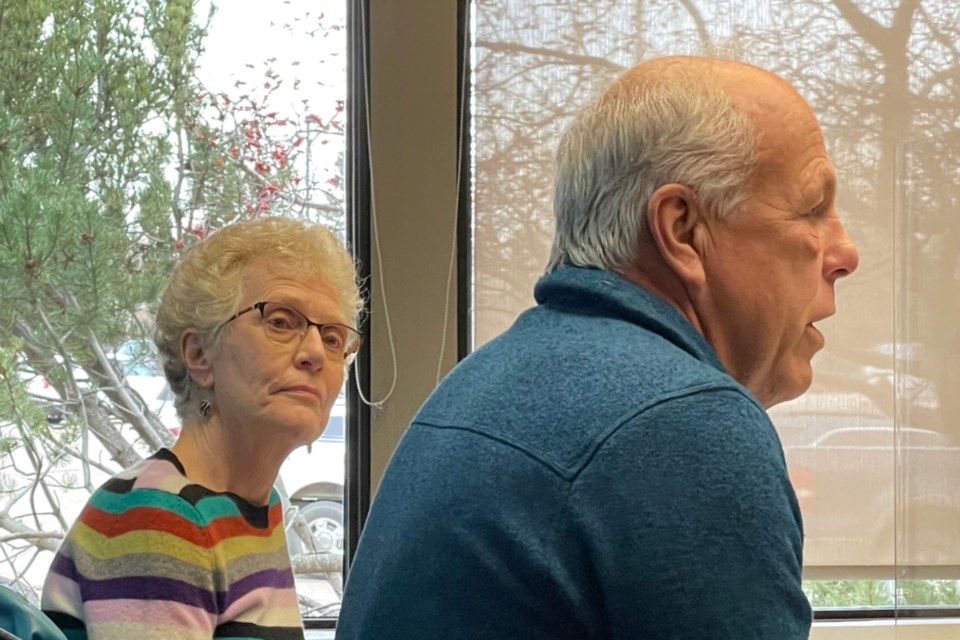
Mavis Jacobs and Town of Athabasca mayor Rob Balay met with Athabasca County council to provide an update on the Keep Athabasca in Athabasca University campaign. File
It was the little community group who could.
Starting with a handful of people in May, the Keep Athabasca in Athabasca University (KAAU) ad-hoc group has grown in size, finances, and reach, especially after hiring a lobbyist.
Starting with a letter writing campaign, then gathering $15,000 in donations from Athabasca County and the Town of Athabasca plus more from community members, they hired Canadian Strategy Group (CSG) in July to help lobby the provincial government.
In December KAAU members John Ollerenshaw and Mavis Jacobs met with Minister of Advanced Education Demetrios Nicolaides and Athabasca-Barrhead-Westlock MLA Glenn van Dijken as well as Town of Athabasca mayor Rob Balay, Village of Boyle mayor Colin Derko and CSG lobbyist Hal Danchilla to discuss steps going forward and ensuring local representation on the board of governors.
“The minister emphasized that (AU) is not moving out of Athabasca and local employment is a priority,” Jacobs said after the Dec. 2 meeting. “Good news is, he is exploring providing clear expectations or a directive to (AU) regarding its responsibility to the community for local job opportunities and economic development.”
She added the KAAU and municipal officials taking part in the meeting emphasized the ripple effect of AU’s near-virtual strategy which is “rapidly destroying many parts of the local economy and is impinging on the social and cultural fabric of our community.”
The group will continue lobbying the government in the New Year and hopes to reinstate some of the more than 400 positions being transitioned out of the Athabasca region.
Boyle emergency care
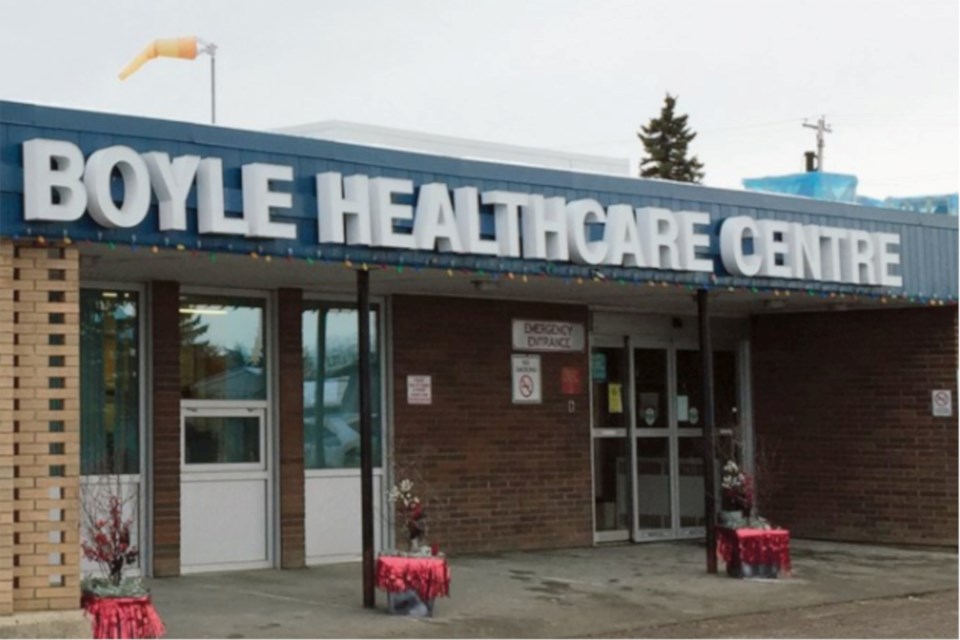
The Boyle Healthcare Centre experienced several short closures of its emergency room over the summer of 2021. File
While healthcare shortages were prevalent across the province in 2021, the Village of Boyle stood as an example of the issues rural communities have been facing with a shortage of doctors and now ambulance services.
The first 24-hour closure of the emergency department at the Boyle Healthcare Centre came on June 7, just days after village council discussed the loss of Dr. Marthinus Doman, who was returning to South Africa after 17 years in the communities. The process to have his replacement start his own practice was long and cumbersome, and would leave Boyle with just one doctor, which led to many more emergency closures over the next several weeks.
During that week alone, the emergency department was closed for 85 of the 193 hours that passed, including two full days and five nights.
The new doctor did arrive in the community in October, but several emergency room closures have still occurred since. The next issue to arise was with ambulance services when a Barrhead ambulance was dispatched for an incident near Boyle on Halloween night, a one hour and 36-minute drive with good road conditions.
At the Nov. 10 council meeting, Boyle fire chief Darren Hill also shared how the shortage of ambulances was affecting volunteer firefighters, noting several instances where firefighters were the only first responders on the scene, and had to use their limited medical training to keep patients alive until an ambulance arrived.
Edwin Parr outbreak
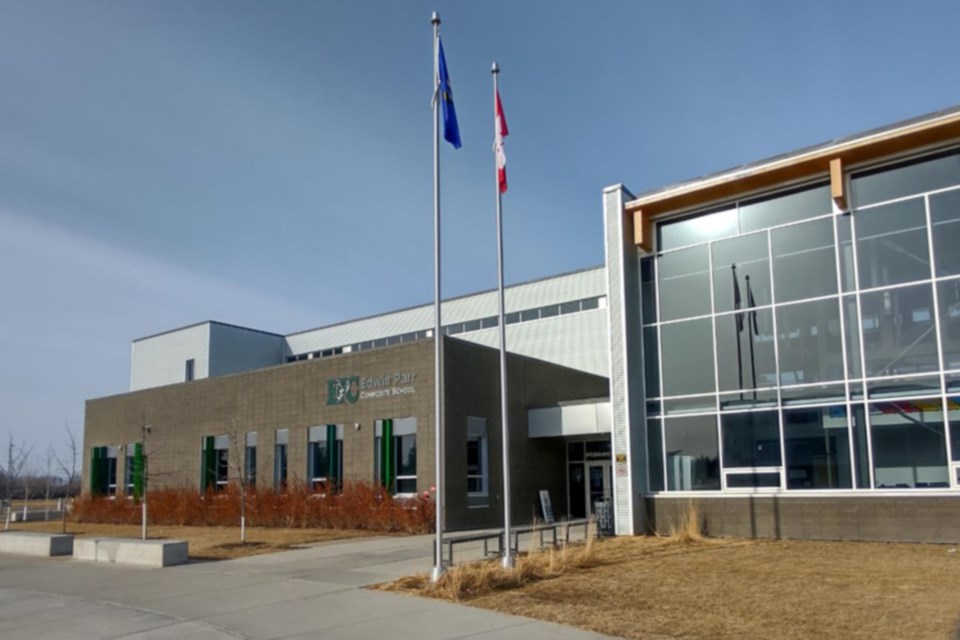
Edwin Parr Composite School was the site of a major COVID-19 outbreak starting in March leading to the return to online learning until May 25. File
In a way, COVID put Athabasca on the map last year, so to speak, at least with Alberta Premier Jason Kenney.
On March 24, Edwin Parr Composite School reported a solitary case of COVID-19, which grew to two by the end of the day, and soon there were 20, with 400 close contacts being advised to stay home. By the next week, 47 cases had been reported and Aspen View Public Schools Supt. Neil O’Shea announced students at EPC would transition to online learning.
By April 2, there were 73 cases with 716 close contacts at Athabasca’s three schools, among students, staff, and bus drivers. This also tipped the number of cases within the borders of Athabasca County to 105.
On April 8, the school division reported 101 active cases at EPC and Athabasca’s two other schools.
At an April 12 press conference premier Kenney mentioned Athabasca by name, saying the outbreak at EPC was caused by out-of-school transmission, specifically a birthday party that had “a 100 per cent attack rate.”
Alberta Health officials later said there was no data to suggest there had been an outbreak from a children’s party in the community, and a spokesperson for the premier said he misspoke about the location of the party and was using it as an example of how easily COVID-19 can spread.
By May, all K-12 learning in the province was moved online, but students were able to return to classes May 25 to finish the school year.
Athabasca County clean sweep
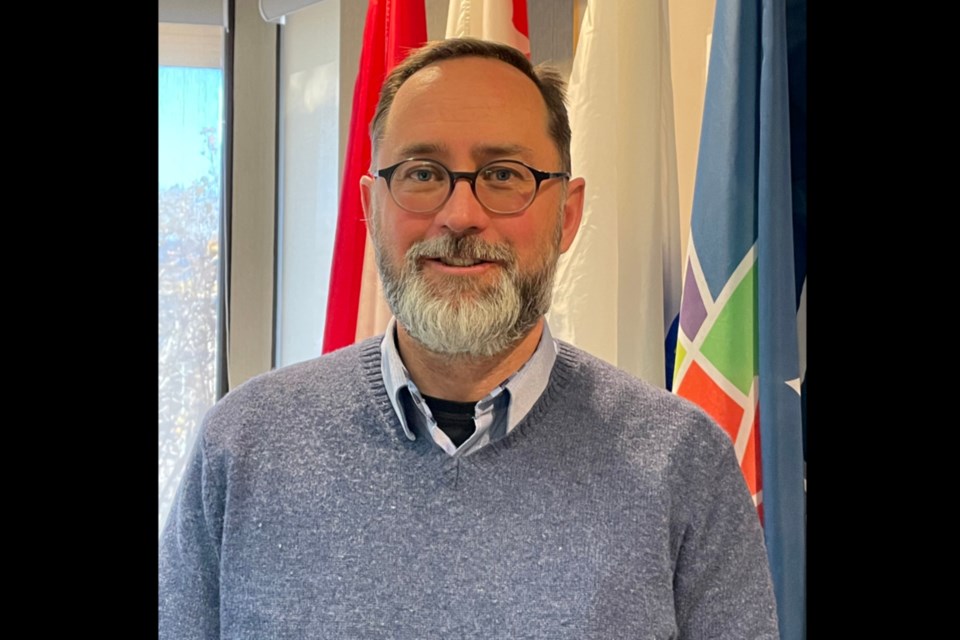
Elected councillor for Division 4, Brian Hall was chosen by his fellow council members to be reeve at the Nov. 1 organizational meeting for Athabasca County. File
Maybe it was a bit of foreshadowing when then-Athabasca County CAO Ryan Maier suddenly resigned right before the June 24 council meeting, or it was the rock that started the slide, but by the end of October there was a new interim CAO and a whole new council.
The formerly amicable council was suddenly fiercely divided between Coun. Kevin Haines, Coun. Doris Splane, Coun. Penny Stewart, Coun. Travais Johnson, Coun. Warren Griffin and Reeve Larry Armfelt against Coun. Dwayne Rawson, Coun. Dennis Willcott and Coun. Christi Bilsky with the last three repeatedly demanding answers from that date until their final meeting before the Oct. 18 municipal election.
When the dust settled, incumbents Rawson, Willcott, and Johnson lost their seats — the other six either chose not to run again or the seat was vacant — and the council was comprised of nine rookie councillors with no political experience except Joe Gerlach who had served 20 years previously.
Since the election, long serving staff have also submitted their resignations – director of infrastructure services Norm De Wet and director of corporate services Amber Oko.
All senior positions including CAO are expected to be filled early in the New Year.
Water intake project
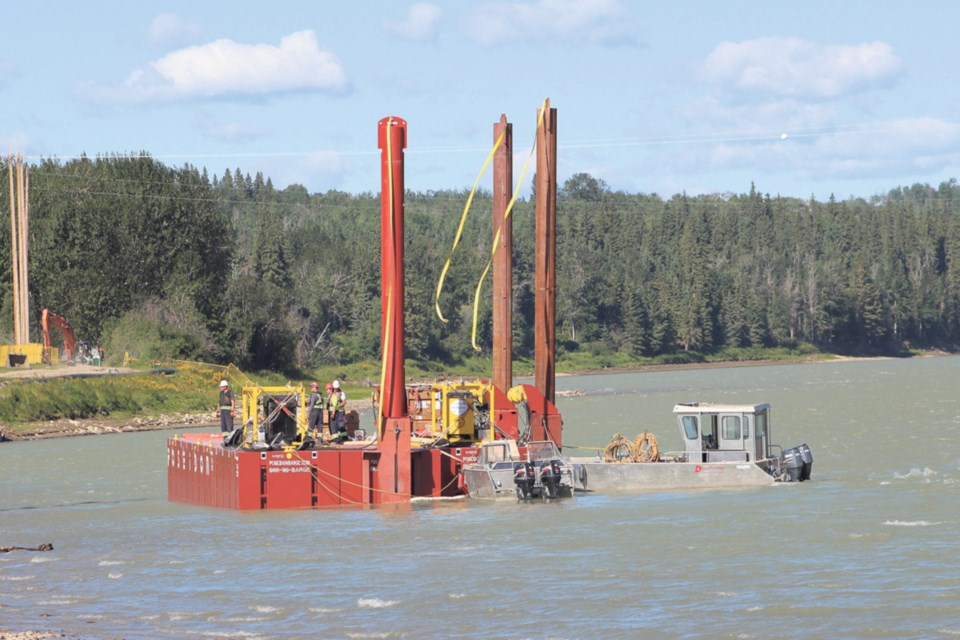
Equipment floated on a man-made island anchored in the Athabasca River as the new water intake pipe was installed. File
The project to replace the Aspen Regional Water Services Commission’s water intake system at the former water treatment plant ran into a few snags last year, after finally getting the funding into place.
That funding, it turned out, didn’t come close to the tenders received and the Town of Athabasca, Athabasca County and Village of Boyle had to dig a lot deeper to make up for the shortfall.
The Town of Athabasca was forced to approve a debenture of $1.3 million (over 30 years) to cover its 63 per cent share in the project. The village also took secured a debenture of $400,000 (over five years) to cover its 20 per cent share in the project, while the county used $340,000 from reserves for its 17 per cent.
The in-river work started in the middle of July with a large crane delivering the barges needed to install the new river pipe arriving, which went well and only required a slight extension.
The indoor work, however, was delayed due to supply chain issues as new pumps and other equipment didn’t arrive as scheduled. The new commission chair Dave Pacholok reported at the town council’s last meeting of the year that the equipment was now arriving, and the work should be completed shortly.
Home Hardware fire
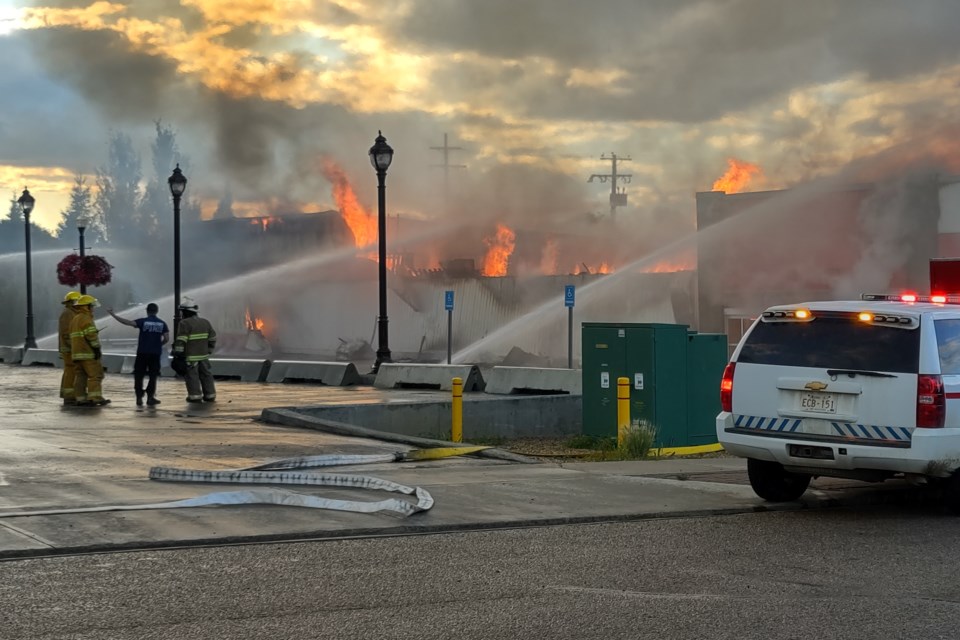
The old Home Hardware building was destroyed in a fire Aug. 11. File
An Aug. 11 blaze that saw the destruction of the former Home Hardware building on the riverfront in downtown Athabasca may have been the largest fire in the town’s history.
The Athabasca Fire Department was able to respond to the fire within minutes, but the building was already engulfed. The Athabasca crew was also joined by firefighters from Boyle, Grassland and Colinton, as they worked throughout the night to extinguish the fire and watch for any hotspots in the following days.
No injuries were reported, and a subsequent investigation found the fire had been intentionally set and deemed arson. Several arsons of abandoned buildings around town in the subsequent weeks led to the arrest of one individual, but the person/people responsible for the Home Hardware fire have not been charged.
The rubble remained on the site until mid-December when it was removed by contractors.
Residential school graves
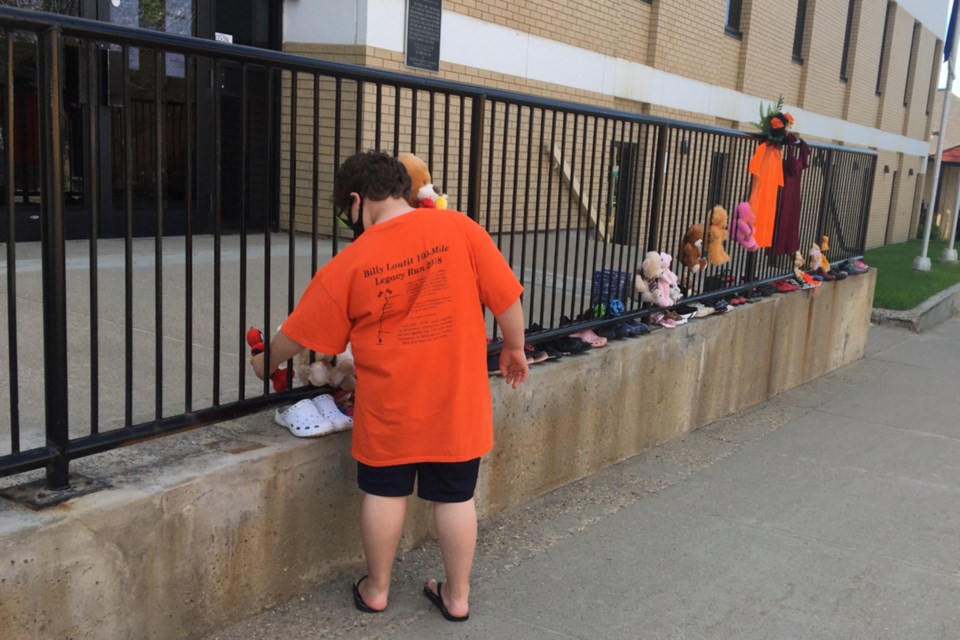
Grade 4 student Isaiah Bouchier places a stuffed toy at a memorial outside the Athabasca Provincial Building to recognize the discovery of 215 unmarked graves. File
Using ground penetrating radar, evidence of 215 unmarked graves was discovered near the Kamloops Indian Residential School in Kamloops, British Columbia May 28.
The lands, now returned to the Tk’emlúps te Secwépemc First Nation, had long been suspected of hiding unmarked burial sites based on the oral histories of survivors of the Canadian Residential school system that ran from the 1870s to the final school being closed in Alberta in 1996.
In June, another 751 graves were found at a former residential school in Saskatchewan and the number kept growing.
To date, 1,874 of the estimated 3,400 unmarked graves have been located.
While there were no Residential schools in Athabasca there are survivors and generation survivors who live in the region making it important for everyone to acknowledge the tragedy and offer support where possible. The Indian Residential School Survivors and Family 24-hour crisis line is 1-800-721-0066.
Remembering Kelsey Thunder
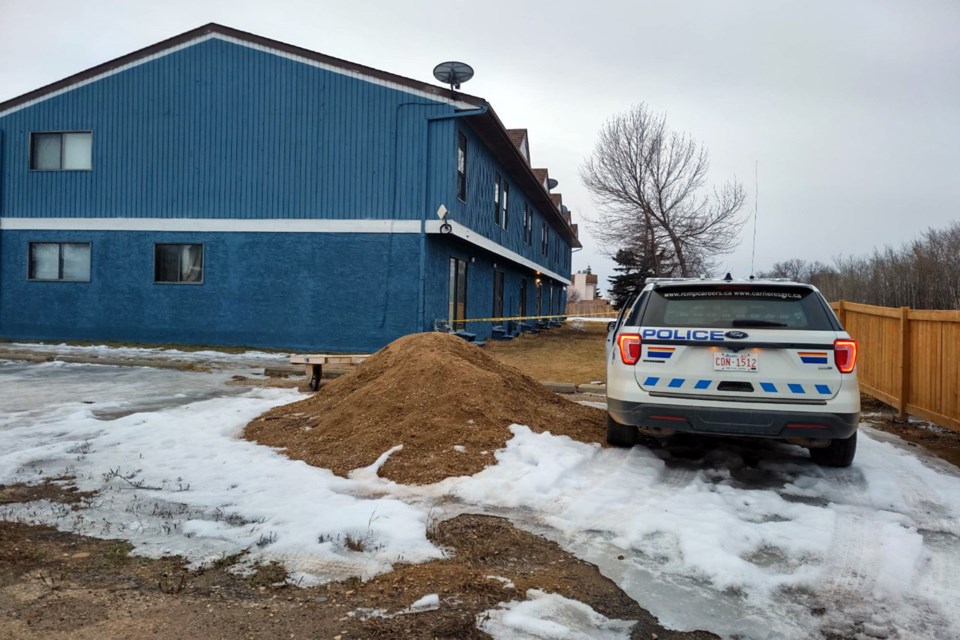
Athabasca RCMP attend the scene of a homicide March 22 at Cornwall Apartments in the townhouse section. Kelsey Thunder was found deceased at the scene and Wyatt Thunder was charged with second-degree murder. File
March 22 was the day 23-year-old Kelsey Thunder was taken from her children and family.
Twenty-six-year-old Wyatt Thunder was arrested and charged that day after RCMP responded to the Cornwall Apartments located on the east side of Athabasca at 3210 Cornwall Dr. at 3:55 a.m. and determined Kelsey was deceased.
At the time an unidentified family member cited foul play which was later confirmed by RCMP, and Wyatt has remained in custody since the incident charged with second-degree murder.
Kelsey left behind three young children.
Magnificent River Rats Festival
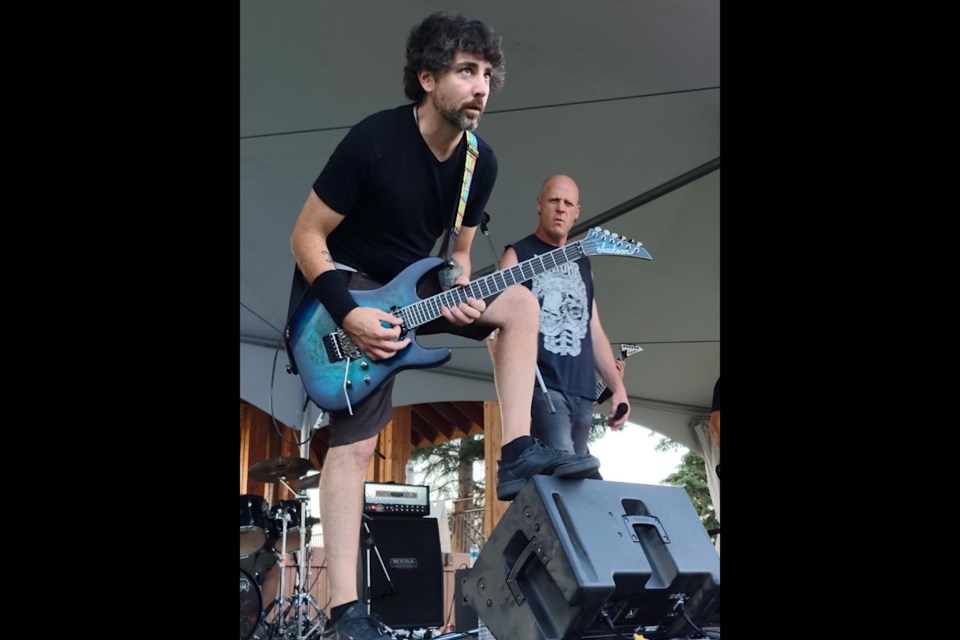
Local rockers Delirium took the stage head-lining the Magnificent River Rats Festival July 1. Richard Nolan plays guitar while Darin Wentworth sings in a Metallica tribute. File
With COVID-19 cases falling and vaccination rates increasing, the Magnificent River Rats Festival returned to Athabasca’s Riverfront Park July 1, for a one-day festival.
Planned in less than a month, the committee pulled in acts like Dirt Road Angels, Eric Creaser, the Richard Woodman Band, and local rockers Delirium.
Even though the event took place on one of the hottest days of summer, it was well attended with over 400 people passing through the gates.
The committee is hopeful COVID-19 rates will allow for a full event in 2022 as it will be the 25th festival being held along the riverfront.
COVID-19 in 2021
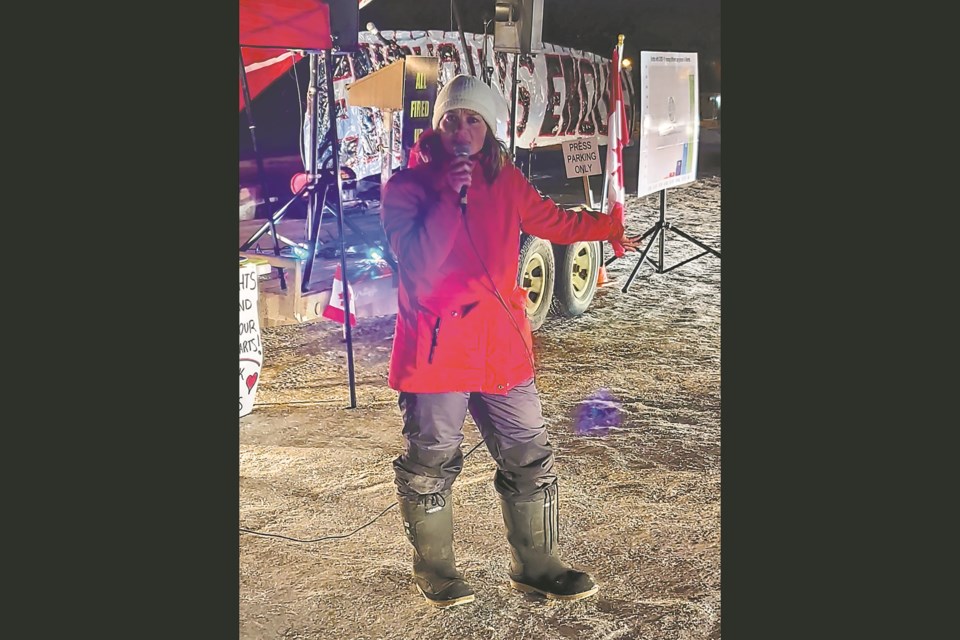
Westlock DJ Benita Pedersen held the first of two “Enough is Enough” rallies in Athabasca in February. File
As much as everyone would like to put it behind them and move on with their lives, COVID-19 still had a major impact on just about all the news in the region in 2021.
The restrictions that had been announced by the province going into Christmas 2020 were extended on Jan. 7 but plans to continue with a return to school for students went ahead as scheduled on Jan. 11. By the middle of January though, some restrictions were relaxed and some personal care businesses, providing one-on-one services, were allowed to start taking clients on an appointment basis.
In February, the first of two “Enough is Enough” rallies organized by Westlock DJ Benita Petersen took place in Athabasca at Riverfront Park. Around this time, the first deaths in the T&C region due to the virus were being reported, and the first vaccines were also being introduced, but supply and delivery issues were plaguing their delivery.
Restrictions were being lifted fast, as the case rate fell and the hope for a return to normality grew — even as the next wave approached, hitting Edwin Parr Composite School and the Town of Athabasca particularly hard.
That experience prompted town council to request that a second “Enough is Enough” rally not take place in the town, which fell on deaf ears, but attracted less than half of the first rally.
The Athabasca region had the highest active case rate per 100,000 in the province at this time at just over 1,000.On June 18, premier Jason Kenney announced the vast majority of restrictions would be lifted in time for Canada Day on July 1, after more than 70 per cent of those eligible for vaccinations got the jab.
Soon after, the Town of Athabasca and Athabasca County rescinded their temporary face-covering bylaws, which had been superseded by provincial mandates for the previous six months.
The region also reached zero cases for a brief time, but case numbers continued to rise and fall after the summer ended, and with 30 per cent of the population still unvaccinated the province reintroduced its masking mandate at the beginning of September. Vaccination numbers also continued to rise as they became available to more and more people, with anyone over five becoming eligible in October.
As of Dec. 30, there have been 960 cases in the Athabasca region since the beginning of the pandemic; 19 are currently active. There have been three deaths related to the virus.



